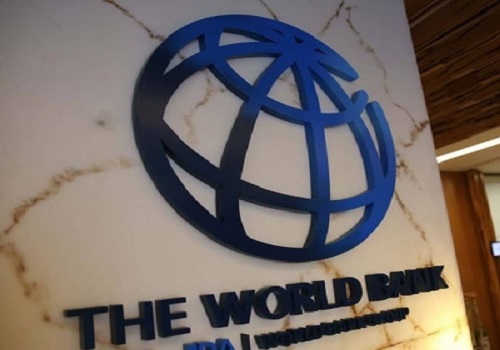Gold trading range for the day is 60175-61015 - Kedia Advisory

Follow us Now on Telegram ! Get daily 10 - 12 important updates on Business, Finance and Investment. Join our Telegram Channel
GOLD
Gold experienced a marginal -0.09% decline, settling at 60657, influenced by a slight increase in U.S. Treasury yields. Despite this, the precious metal found support from the belief that U.S. interest rates have peaked. Concerns about a slowing U.S. job market and lower-than-expected consumer inflation prompted a shift in market forecasts, with attention now on the potential timing of rate cuts by the Federal Reserve. The central bank is expected to maintain rates in December. Recent data revealed a slowdown in U.S. consumer inflation for October, coupled with the first decline in retail sales in seven months and an increase in unemployment benefit claims. In India, buyers disregarded local price highs during Diwali, sustaining gold purchases, while China maintained premiums with continued gold accumulation by the top buyer. Sales of coins and bars increased, and jewelry demand saw improvement. Technically, the gold market is undergoing long liquidation, with an -11.6% drop in open interest and a price decrease of -56 rupees. Support is identified at 60415, with a potential test of 60175 on the downside, while resistance is anticipated at 60835, with a possible test of 61015 on the upside.
Trading Ideas:
* Gold trading range for the day is 60175-61015.
* Gold prices edged lower weighed by a slight uptick in U.S. Treasury yields.
* Fed vice chair for supervision Michael Barr said officials are likely at or near the end of their tightening campaign.
* San Francisco Fed president Mary Daly said policymakers aren't certain inflation is on a path to their 2 percent target.
SILVER
Silver faced a decline of -0.68%, settling at 72644, influenced by an improvement in risk sentiment in equity markets. Chinese officials' commitment to implementing additional stimulus measures for the struggling property sector contributed to a positive shift in the overall market mood. China's central bank maintained its loan prime rate at record lows and injected liquidity into markets through reverse repos, aiming to support the real estate sector. Meanwhile, the dollar, remaining below over two-month lows, reflects expectations that the Federal Reserve will refrain from raising interest rates for several months before potential rate cuts in mid-2024. Fed officials, including vice chair Michael Barr and San Francisco Fed president Mary Daly, signaled a cautious approach, indicating the possibility that the tightening campaign may be nearing its end. The uncertainty about inflation reaching the 2 percent target adds to the cautious stance. Technically, the silver market is undergoing long liquidation, with an -8.25% drop in open interest and a price decrease of -496 rupees. Support is identified at 72020, with a potential test of 71390 on the downside, while resistance is anticipated at 73320, with a possible test of 73990 on the upside.
Trading Ideas:
* Silver trading range for the day is 71390-73990.
* Silver dropped as risk sentiment improved in equity markets
* Chinese officials to roll out more stimulus measures for the country's beleaguered property sector.
* Fed will refrain from raising interest rates over the next several months before cutting rates in mid-2024.
CRUDE OIL
Crude oil surged by 3.1%, closing at 6543, driven by heightened expectations of major producers, particularly within OPEC+, implementing deeper voluntary production cuts in their upcoming meeting on November 26 in Vienna. The speculation is fueled by the potential for OPEC+ members, notably Saudi Arabia and Russia, to enhance their existing output cuts of 5.16 million barrels per day, approximately 5% of global daily demand, initiated in late 2022. Adding to the bullish sentiment, U.S. oil refiners are projected to have 264,000 barrels per day of offline capacity for the week ending November 24, increasing available refining capacity by 559,000 bpd. Meanwhile, geopolitical tensions in the Middle East, with progress reported in negotiations to release hostages in Gaza despite ongoing conflict, contribute to market dynamics. On the domestic front, U.S. energy firms bucked a three-week trend by adding oil and natural gas rigs, with the oil rig count witnessing its most significant increase since February. The overall oil and gas rig count, considered an early indicator of future output, rose by two to 618 in the week ending November 17. U.S. oil rigs increased by six to 500, while gas rigs declined by four to 114, reaching their lowest level since early September. Technically, the market indicates short covering, with a substantial -15.4% drop in open interest and a price increase of 197 rupees. Support is identified at 6428, with a potential test of 6313 on the downside, while resistance is anticipated at 6603, with a possible test of 6663 on the upside.
Trading Ideas:
* Crudeoil trading range for the day is 6313-6663.
* Crude oil prices rose on expectations of deeper supply cuts
* There is buzz that OPEC+ is considering deeper output cuts at the 26 November meeting in Vienna to shore up prices.
* U.S. oil refiners are expected to have 264,000 barrels per day (bpd) of capacity offline
NATURAL GAS
Natural gas settled down by -1.23%, closing at 241.5, driven by record output levels, allowing utilities to continue injecting gas into storage well into late November. Typically, by mid-November, utilities transition to pulling gas from storage to meet heating demand. As of the week ended November 10, U.S. gas stockpiles were already 6% above normal and were projected to reach 7% above normal by the week ended November 17. This abundance of gas in storage, coupled with record-high production, has led to a market sentiment indicating diminishing hopes of price spikes during the winter of 2023-2024. The average gas output in the Lower 48 U.S. states rose to 107.2 billion cubic feet per day (bcfd) in November, up from a record 104.2 bcfd in October. However, recent data shows a slight decline, with output on track to drop to a preliminary two-week low of 105.7 bcfd. Meteorologists forecast warmer-than-normal weather through November 21, followed by a shift to colder-than-normal conditions from November 22 to December 2. With the anticipation of colder weather, U.S. gas demand is expected to rise from 112.0 bcfd this week to 112.4 bcfd next week and then soar to 126.7 bcfd in two weeks. From a technical standpoint, the market is undergoing long liquidation, marked by a -5.3% drop in open interest and a price decrease of -3 rupees. Support is identified at 238.4, with a potential test of 235.2 on the downside, while resistance is anticipated at 245.7, with a possible test of 249.8 on the upside.
Trading Ideas:
* Naturalgas trading range for the day is 235.2-249.8.
* Natural gas fell on record output that should enable utilities to keep injecting gas into storage through late November.
* Gas production in North Dakota rose to a record 3.440 bcfd in September.
* Average gas output in the Lower 48 U.S. states rose to 107.2 billion cubic feet per day (bcfd) so far in November
COPPER
Copper witnessed a notable 0.86% increase, settling at 717.6, propelled by a three-day strike initiated by the workers' union at Peru's major Las Bambas copper mine, owned by China's MMG Ltd. This labor action raised concerns about potential disruptions to copper supply, contributing to the upward momentum in prices. Additionally, the weakening U.S. dollar, reaching a two-month low, played a significant role as traders reconfirmed their belief that U.S. interest rates have peaked, shifting focus to the potential for rate cuts by the Federal Reserve. China's commitment to supporting the property sector, a significant consumer of copper and other base metals, added further support to the market. Notably, China's refined copper production surged by 13.3% in October year-on-year, reaching 11.3 million metric tons, according to data from the National Bureau of Statistics. Declining inventories at the Shanghai Futures Exchange (SHFE) on November 17th underscored the immediate demand for copper, triggering an increase in the Yangshan copper premium. Simultaneously, evidence of slowing prices in the U.S. strengthened expectations that the Federal Reserve would refrain from further interest rate hikes, leading to a decline in the U.S. dollar. From a technical perspective, the market is experiencing short covering, evident in the -20.58% drop in open interest and a price increase of 6.1 rupees. Support is identified at 714.3, with a potential test of 710.9 on the downside, while resistance is anticipated at 719.8, with a possible test of 721.9 on the upside.
Trading Ideas:
* Copper trading range for the day is 710.9-721.9.
* Copper rose as Union strike starts at MMG'S Peru Las Bambas copper mine
* China's refined copper production in October jumped 13.3% to 11.3 million metric tons year-on-year
* Copper inventories in warehouses monitored by the Shanghai Futures Exchange fell 11.0 % from last Friday.
ZINC
Zinc experienced a modest uptick of 0.35%, settling at 227.95, driven by a softer dollar and optimistic sentiments regarding increased demand. The boost came after Chinese officials reassured support for the country's property sector, with the central bank and financial regulators pledging to ensure financing and address local government debt risks. The commitment aims to stimulate the economy, mitigating financial risks associated with a property downturn and substantial local government debt totaling 92 trillion yuan ($12.77 trillion). The focus on sustaining the property sector contributes positively to zinc demand. Notably, China's refined zinc output recorded robust growth, reaching 604,600 mt in October, a month-on-month increase of 11.14% and a year-on-year surge of 17.6%. Domestic zinc alloy production in October also saw a notable increase, indicating a healthy production environment for the metal. However, concerns about potential output cuts by zinc smelters in Yunnan due to power rationing impose some limitations on the market's upside. Inventories of zinc in LME approved warehouses nearly doubled due to significant arrivals after months of dwindling stocks, according to LME data. Technically, the market is undergoing short covering, evident in the -20.21% drop in open interest and a price increase of 0.8 rupees. Support is identified at 226.8, with a potential test of 225.5 on the downside, while resistance is anticipated at 229.5, with a possible test of 230.9 on the upside.
Trading Ideas:
* Zinc trading range for the day is 225.5-230.9.
* Zinc prices gained amid a softer dollar and hopes of improving demand
* China's central bank and financial regulators pledged to ensure financing support for the property sector
* China's refined zinc output was 604,600 mt in October, a growth of 60,600 mt or 11.14% month-on-month
ALUMINIUM
Aluminium closed with a significant gain of 1.01%, settling at 205.45, driven by developments in China's southwestern Yunnan province, where smelters initiated cuts totaling 1.15 million tons of capacity in response to power curbs anticipated until April. This reduction in capacity, aimed at complying with power constraints, influenced the positive momentum in aluminium prices. Importantly, China's aluminium imports marked their fifth consecutive monthly increase in October, as revealed by customs data. The world's leading consumer and producer of aluminium imported 351,065 metric tons of unwrought aluminium and related products last month. This figure represents a 5.8% rise from September and a substantial 78.7% increase from the same period last year. Solid demand and expectations of reduced domestic supply contributed to the improved buying appetite for imported aluminium. In the broader economic context, China's central bank and financial regulators reinforced their commitment to supporting the property sector and addressing local government debt risks. This strategic move is part of China's broader efforts to revive its economy and mitigate potential financial risks associated with a property downturn and substantial local government debt totaling 92 trillion yuan ($12.77 trillion). Technically, the aluminium market is undergoing short covering, marked by a -15.17% drop in open interest and a price increase of 2.05 rupees. Support is identified at 204.8, with a potential test of 204.2 on the downside, while resistance is anticipated at 205.9, with a possible test of 206.4 on the upside.
Trading Ideas:
* Aluminium trading range for the day is 204.2-206.4.
* Aluminium gains as smelters in southwestern Yunnan province started cutting a total of 1.15 million tons of capacity in early November
* Fears of reduced domestic supply propelled more buying from abroad
* China's Oct aluminium imports rise on solid demand, fears of reduced domestic supply
COTTONCANDY
Cottoncandy prices experienced a marginal decline of -0.45%, settling at 56960, attributed to profit booking after recent support. India's cotton production for 2023/24 is expected to decrease by 7.5% to 29.5 million bales due to lower planted areas and the impact of El Niño weather conditions, as reported by the Cotton Association of India (CAI). Import estimates suggest a potential increase to 2.2 million bales, compared to the previous year's 1.25 million bales. The U.S. cotton balance sheet for 2023/24 indicates slightly lower consumption but higher production and ending stocks. Higher production at 13.1 million bales, with Texas offsetting lower production elsewhere, is noted. Domestic mill use is slightly lower, while exports remain unchanged, resulting in higher ending stocks at 3.2 million bales. Globally, the 2023/24 cotton balance sheet shows lower consumption but higher production and stocks. Beginning stocks increased by 200,000 bales, primarily due to a 300,000-bale rise in India's 2022/23 production. CAI's final estimate for the 2022-23 cotton crop production stands at 31.8 million bales, slightly higher than the initial estimates. However, this differs from the government's estimate of 34.3 million bales. In north Maharashtra, cotton production is anticipated to decline by 25% due to insufficient rainfall, impacting about 10 lakh hectares of land. The normal annual cotton production in the region is around 20 lakh tonnes. Rajkot, a major spot market, witnessed a price drop of -0.31%, ending at 27188.4 Rupees. Technically, the market is undergoing long liquidation, with a -7.29% drop in open interest. Support is identified at 56760, with a potential test of 56550, while resistance is anticipated at 57220, with a possible test of 57470.
Trading Ideas:
* Cottoncandy trading range for the day is 56550-57470.
* Cotton dropped on profit booking after prices gains as India's cotton production in 2023/24 is likely to fall 7.5%
* Cotton production likely to decline by 25% in north Maha
* USDA cut U.S. production in 2023/24 to 12.8 million bales
* In Rajkot, a major spot market, the price ended at 27188.4 Rupees dropped by -0.31 percent.
TURMERIC
Turmeric prices experienced a decline of -1.59%, settling at 12496, primarily driven by concerns among farmers in Maharashtra over the location of PM Modi's Turmeric Board in Telangana. Slow buying activities were noted, as market participants awaited the release of stocks ahead of the new crops expected in January 2024. Pressure on prices also emerged due to improved crop conditions resulting from favorable weather. The crop is expected to be ready for harvest from January to March, with October projected to be drier than average, impacting crop growth. Despite current lower buying activity and decreasing supplies, price stability is anticipated, supported by improved export opportunities. Exports have increased by 25% as demand for turmeric has risen in both developed and emerging nations. Expectations of a 20–25% decline in turmeric seeding, particularly in Maharashtra, Tamil Nadu, Andhra Pradesh, and Telangana, contribute to the downside. However, the potential for yield losses due to unfavorable weather conditions poses a limitation. Turmeric exports during April-September 2023 increased by 4.14% to 92,025.16 tonnes compared to the same period in 2022. September 2023 witnessed a drop in exports to 9,085.81 tonnes, down 35.06% from September 2022. In Nizamabad, a major spot market, turmeric prices ended at 13315.3 Rupees, marking a -0.64% decrease. Technically, the market is undergoing long liquidation, with a -0.92% drop in open interest. Support is identified at 12304, with a potential test of 12112, while resistance is anticipated at 12744, with a possible test of 12992.
Trading Ideas:
* Turmeric trading range for the day is 12112-12992.
* Turmeric dropped after PM Modi's Turmeric Board in Telangana sparks farmer concerns in Maharashtra over HQ location.
* In Sep 2023 around 9,085.81 tonnes exported as against 11,322.58 tonnes in Aug 2023 showing a drop of 19.75%.
* Expectations for a 20–25 percent decline in turmeric seeding this year
* In Nizamabad, a major spot market, the price ended at 13315.3 Rupees dropped by -0.64 percent.
JEERA
Jeera prices witnessed a significant uptick, rising by 5.97% to settle at 45600, driven by low-level buying after a recent drop in prices. Adequate soil moisture and favorable weather conditions for crop cultivation are expected to boost overall sowing activities, contributing to the recent downturn in prices. Stockists are showing interest in buying, triggering short covering. However, global demand for Indian jeera has slumped as buyers prefer other origins like Syria and Turkey due to higher prices in India. Export activities are likely to remain subdued in the upcoming months due to seasonality and the competitive pricing of Indian jeera in the global market. This lack of price competitiveness is affecting exporters and is expected to keep export activity subdued in the coming weeks. Jeera exports during April-September 2023 dropped by 29.79% to 76,969.88 tonnes compared to the same period in 2022. In September 2023, jeera exports totaled 7,190.83 tonnes, reflecting an 11.02% drop from August 2023 and a significant 60.27% decline from September 2022. The possibility of China purchasing Indian cumin in October-November before the arrival of new cumin adds uncertainty to the market dynamics. In Unjha, a major spot market, jeera prices ended at 46293.15 Rupees, marking a gain of 2.18%. Technically, the market is undergoing short covering, with a -0.37% drop in open interest. Support is identified at 44690, with a potential test of 43790, while resistance is anticipated at 46050, with a possible test of 46510.
Trading Ideas:
* Jeera trading range for the day is 43790-46510.# Jeera gains on low level buying after prices dropped as favorable condition for crop will boost the overall sowing activities.
* The upcoming sowing of jeera that is expected to remain normal due to favorable weather condition.
* Stockists are showing interest in buying on recent downfall in prices triggering short covering.
* In Unjha, a major spot market, the price ended at 46293.15 Rupees gained by 2.18 percent.
Views express by all participants are for information & academic purpose only. Kindly read disclaimer before referring below views. Click Here For Disclaimer






















